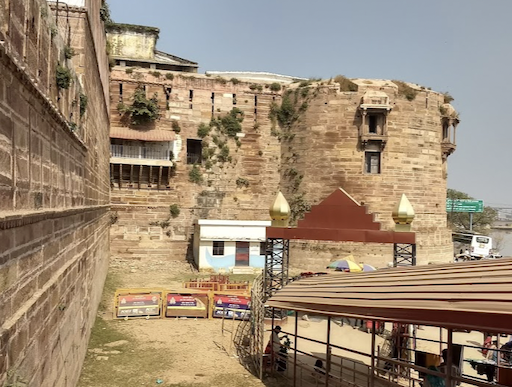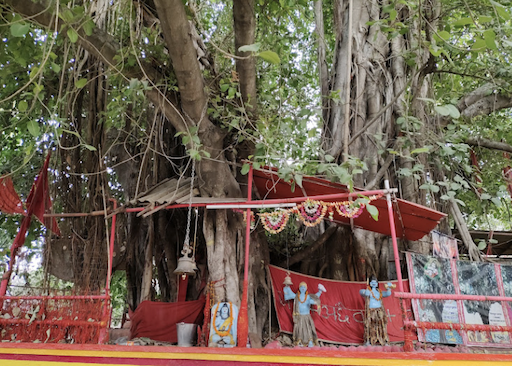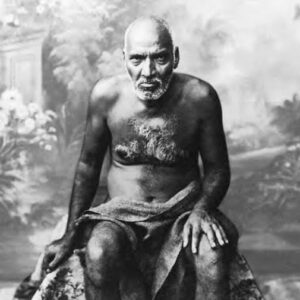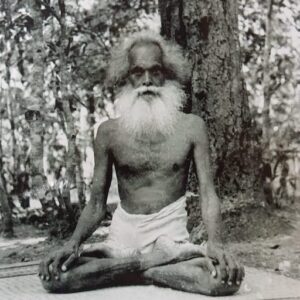This is a covered saraswati koop inside the Akshyavat Temple Patalpuri located within Akbar Fort. As you enter the underground temple and go to the other side of the entrance, you will be able to see the circular marking on the floor which reads ‘Saraswati koop (well) closed off by Mughals’. There is a place to sit and meditate. You can go into meditative states here effortlessly.
How to Get there
The temple is located 6.5 kms East of Prayagraj Junction.
Map:
https://goo.gl/maps/kKwXNaQtS2xDw1Xe6
About Akshyavat Temple Patalpuri
the ancient Patalpuri Temple and the extraordinary Akshayavata. Akshayavata is derived from the Sanskrit words akshaya meaning eternal or imperishable or indestructible and vata meaning banyan or sacred fig and therefore, literally translates to the eternal banyan (fig).
According to the Hindu scriptures, at the time of the Maha Pralaya (the great dissolution of creation {universe}] when there is only water all round and no sign of life, Markandeya Maharshi has darshan of Lord Krishna in the form of Bala Mukunda on a gigantic leaf of the vata vriksha (banyan tree). It is this sacred tree that is the foundation for all creation and known as the Tree of Knowledge and Wisdom (Jñāna, Vijñāna and Prajñāna).
This imperishable tree of Creation has attracted the attention of Muslim invaders (from the time of Mahmud of Ghazni to Jahangir from the Mughals and his successors) who tried in vain to burn it, but much to their astonishment, every time an attempt was made, another tree would spring up from the ashes!
Lord Rama, Sita Mata and Lakshmana are said to have rested under this divine tree on the instructions of Bharadwaja Brahmarshi during their exile. Lord Rama is said to have performed jal abhishek to the Shiva Linga of Shool Tankeshwar consecrated by Lord Brahma. Interestingly, the water poured over Shool Tankeshwar runs straight into the deep roots of Akshayavata and reaches the Sangam. The invisible Saraswati River is also said to run under the Akshayavata and become a part of the Triveni Sangam.
According to the priests, Lord Rama had gone to collect the items required to do the pind daan karma after the demise of his father Raja Dasharatha. Sita Mata was waiting for his return when suddenly Raja Dasharatha made his appearance at Akshayavata and asked for some food saying he was hungry. Sita Mata did not know what to do and looked around. She then collected some sand from under the Akshayavata and made a pind (ball) of sand and offered it to Raja Dasharatha.
The sparsha (touch) and blessings of Sita Mata has made Akshayavata the most sacrosanct shrine in Prayag. It is imperative that one takes a dip in the Sangam and have darshan of the legendary Akshayavata for augmentation of their lineage and to be rid of mental and physical ailments. A trip to Prayag is deemed to be complete only if one has a bath in the Sangam and offers prayers at Akshayavata.
It has been stated in the Hindu scriptures that Lord Brahma performed the first yaga under the vata vriksha invoking all the thirty-three crore Gods and Goddesses. This town was given the name Prayag (derived from the Sanskrit words pratham meaning first and yaga meaning an offering of renunciation) after the completion of this yaga.
An ancient pool called Kamkoop (Kamkoot) used to be near the Akshayavata in the olden times. It used to be a common sight to see people jumping on the branches of the tree and give up their life in the Kamkoop. This was based on the belief that they would be given a superior body in their next birth. This practice has been mentioned by Hiuen Tsang in his travelogues.
Akbar built the Allahabad Fort and retained the Akshayavata within the fort but closed the Kamkoop. Akbar and his men tried several times to burn down the tree but failed. There is a Saraswati Koop within the fort premises of great antiquity which is from where the Saraswati River flows to join Ganga and Yamuna.
Patalpuri Temple as the name suggests is a temple built underground. This temple is said to have existed since the Vedic period and is one of the oldest temples in Akhanda Bharat. The temple has some exquisite artwork and decoration.
The temple is located below the courtyard of the fort and is eighty-four feet lengthways (east-west) and forty-nine feet widthways (north-south). The stone roof rests on pillars that are a little over six feet in height. There are about hundred columns with the main entrance in the west.
A small passage at the bottom of a flight of steps takes you to the temple. A large statue of Dharmaraja greets you at the entrance with more statues of Lord Ganesha, Gorakhnath, Kali Mata, Lord Narasimha, Lord Vishnu, Lakshmi Devi, Lord Mahadev, Durvasa Maharshi, Prayagraj, Baidyanath, Kartik Swami, Anasuya Mata, Varuna, Kala Bhairav, Lalitha Devi, Ganga Mata, Yamuna Mata, Saraswati Devi, Suryanarayan, Jambavat, Guru Dattatreya, Banganga, Satyanarayan, Shani Bhagawan, Markandeya Maharshi, Guptadaan, Shool Tankeshwar Mahadev, Parvati Devi, Veni Madhav, Kuber Bhandari, Sankat Mochan Hanuman, Koteshwar Mahadev, Lord Rama along with Sita Mata and Lakshmana, Naga Vasuki, Yamaraja, Siddhivinayak, Suryadev and others placed inside.
Read More:
https://sahasa.in/2021/12/22/patalpuri-mandir-and-akshayavat-prayagraj-uttar-pradesh/





